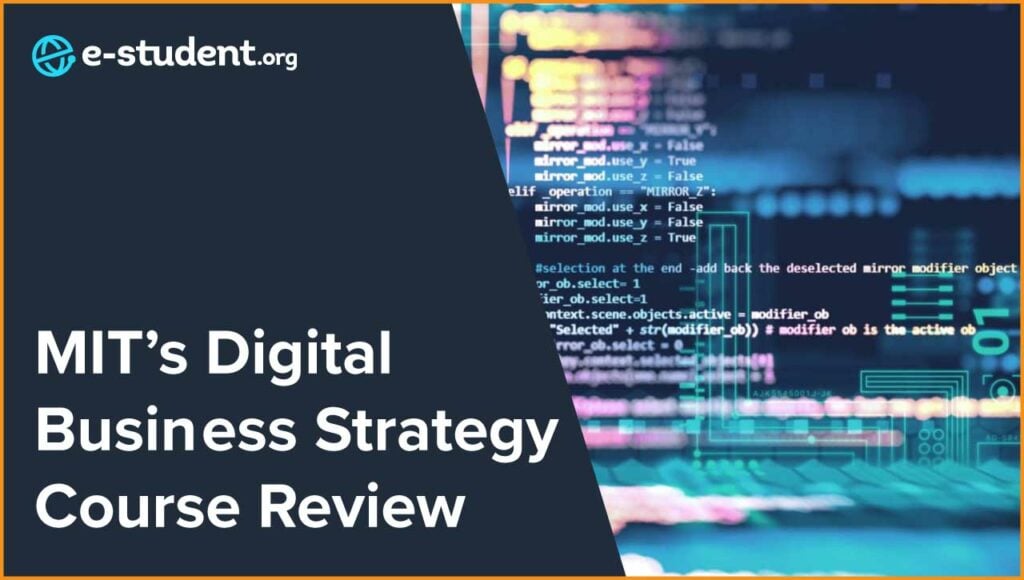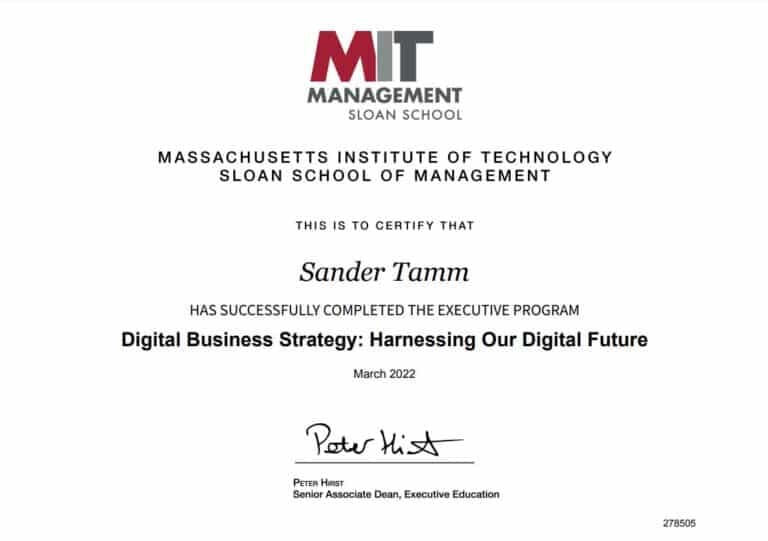
This year, I enrolled in and completed MIT’s Digital Business Strategy course on GetSmarter: a 6-week, self-paced online course led by MIT faculty Andrew McAfee and Erik Brynjolfsson. In this article, I will review my experiences with the course and provide my thoughts as to whether or not I believe the course is worth the time and money.
If you’re interested in the course after reading this review, make sure to request a course brochure from GetSmarter to learn more (you will have to enter your email, but you can easily unsubscribe).
But first, a little bit about my background in digital businesses.
In terms of official education, I have a degree in medical diagnostics, but I have been working as a digital marketer and digital media content creator for the last five years. I operate my own online business and have followed and reviewed online business courses, and while that sounds like a decent background for a course like this, it’s actually not as relevant as you might think.
In truth, I had virtually zero knowledge of the topics covered in this course outside of basic knowledge of blockchain technology and digital economics. While the subject matters were new to me, I felt they could be of great use in my business, and I wanted a comprehensive yet understandable overview of transformative business practices and their potential applications. So, with that in mind, I ended up taking MIT’s Digital Business Strategy course as it seemed like an excellent fit for my needs.
By now, I have gone through the entire curriculum, completed all the homework assignments, and had time to reflect on the experience. In this review, I’ll be detailing my personal experiences, the pros and cons, and some final remarks about whether the course met my expectations.
Let’s jump right into it.
Table of Contents
What did the learning experience look like?
Here’s what the learning journey looks like if you take MIT’s Digital Business Strategy course:
1. Sign up for the course.
Unlike courses on many other online learning platforms, GetSmarter courses take place in cohorts. Thus, if you sign up for the course a few months in advance, you will have to wait until the official course start date to access the learning materials. I would argue, though, that being part of a cohort of students is a net positive in terms of the overall learning experience. It allows you to interact with other students in the comments section, and it also gives you a sense of camaraderie and responsibility towards completing the course.
2. Get access to the student dashboard on the start date.
On the course starting date, you are provided with your login details for the online campus. After reading and accepting the honor code, plus updating your profile, you are all set to start learning. The first week is not very heavy on workload and is meant chiefly for onboarding, so you can take your time to get familiar with the platform and the navigation.
This is also a good moment to start thinking about what company you’ll be using for the homework assignments. Namely, in the upcoming homework assignments, you’ll analyze potential digital transformation methods for a real company. To get the most value possible out of these assignments, I recommend you start thinking about what company you’ll want to use as early as possible. More on that later, though.
3. Begin working through the course curriculum.
Once you start the second week, the real work begins.
From here on out, every week will give you access to a new learning module full of learning materials. This includes lectures in video and text format, homework assignments, enrichment activities, and group discussions, together with some extracurricular materials. Every week will have a different theme, and the topics will build upon each other in a logical sequence.
The video content often takes place in a dialogue between Brynjolfsson and McAfee, while the group discussions usually take place within small groups of around nine students. It’s also worth mentioning that every video includes a download link to a .pdf transcript. This has been very helpful for me as I personally prefer to read materials in a written format rather than watching videos or listening to audio recordings.
4. Pass all assignments and get your final grade.
After the sixth and final module, you’ll have extra time to pass all the prior assignments and receive your final grade. While most of the assignments are graded, you don’t need a perfect score to receive your certificate, and simply having them marked as “Completed” by the reviewers is enough to pass the course. On one occasion, I also had to request a homework deadline extension, which was quickly granted to me without any issues.
5. Get your MIT certificate of completion
Once all of your assignments are marked as “Completed,” and you receive your final grade, you are finally eligible to receive your certificate of completion from the MIT Sloan School of Management. My certificate was in a digital format and hosted on the Accredible digital badge and certificate platform. It’s verified on a blockchain, includes information about the date of issuance, and includes a signature from Peter Hirst, the Senior Associate Dean of Executive Education at MIT Sloan School of Management.
If you’re interested, here’s my certificate of completion:

And, here you can find it within the Accredible digital certificate ecosystem. This certificate is easy to print, add to your LinkedIn profile, or embed anywhere. GetSmarter used to send out physical certificates of completion, but I prefer the digital version, as nowadays having an easily verifiable digital certificate is more valuable than a piece of paper. After all, your LinkedIn profile is probably seen by far more potential employers than your physical certificate.
Now, let’s continue by highlighting the main topics covered in this course.
What are the topics covered within MIT's Digital Business Strategy course?
As mentioned before, lessons within this course are categorized into six modules, each taking one week to complete. Every week, you get access to a new module, and every week, you are expected to complete the homework assignment for the relevant module.
These are the weekly modules, together with their respective topics:
- Module 1: Introduction to digital transformation.
- Module 2: Artificial intelligence (AI).
- Module 3: Digital economy.
- Module 4: Digital platforms & their value.
- Module 5: Crowd participation & the second machine age.
- Module 6: Decentralization & blockchain.
These are the general topics covered within this course, but in practice, the lessons usually dive deeper into sub-topics as well.
For example, the artificial intelligence module also contains lessons on deep learning topics such as neural networks, supervised learning, and reinforcement learning. And in one of the modules, you’ll find lessons on System 1 and System 2 Thinking which I found particularly engaging.
How much does the course cost?
MIT’s Digital Business Strategy course costs $2,800. This is quite a hefty price tag, but it is rather reasonable when you consider that the course is taught by faculty from one of the world’s most prestigious universities: MIT. As far as technology education goes, MIT is undoubtedly one of the top educational institutions in the world, and becoming certified by such an institution comes with a certain level of prestige.
GetSmarter also offers a split payment plan for courses with a duration of nine weeks or less. As MIT’s course is six weeks long, you have the option of splitting the course payment into two equal-sized installments.
If you’re not sure whether you want to commit to taking the course, GetSmarter also offers a generous refund policy. Namely, within 21 calendar days of your course starting date, you are eligible for a full refund of the course fee. This offer is more generous than many other online learning platforms’ refund policies, many of which offer no refund after you access the learning materials for the first time.
Regardless, as this course is a considerable investment, make sure to request the course brochure from GetSmarter for additional information (you will have to enter your email, but you can easily unsubscribe).
What are the homework assignments like?
After all these mentions of homework assignments, you may already be stressed out that you won’t have enough time to complete the homework assignments within the required timeframe. After all, the program was supposed to be meant for working professionals with a limited amount of time on their hands. However, honestly, there is no reason to worry.
The homework assignments typically only took me a few hours per week to complete, and the system is rather flexible in that it allows you to implement what you learned into your own company. You don’t need to become an expert on Google’s machine learning algorithms to pass the assignments, and you don’t even need to code anything if you don’t want to.
The assignments are more like brainstorming sessions, where you have to develop creative ways of implementing digital transformation within your business.
For example, in one of the early assignments, you may be asked to analyze how a rival firm that is beginning to employ machine learning algorithms might affect your business. Or, other assignments may have you writing a memo to the CEO of your company detailing how your business could capitalize on the benefits of a platform-based business model and what kinds of pricing strategies you could employ.
During these assignments, you will have to combine your existing topical expertise with the knowledge gained from the course, and this is where the real value of the program lies. It forces you to devise disruptive solutions by yourself without giving you a ready-made answer key.
And, if you don’t have a company in mind that you want to analyze for these assignments, MIT also provides you with an example company that you can use as a reference for these assignments. Personally, though, I found it more engaging to choose my own company for these exercises.
The only gripe I have with the assignments is that I would have liked some more diversity. All of the assignments were in an essay format, and while the topics were interesting, I would have found completing the assignments more engaging if there had been some other types of assignments, such as quizzes or practical exercises sprinkled in. Overall, though, I still found the assignments to be very valuable learning experiences.
Review conclusion: was I satisfied with the course?
Before taking this course, I only had a very rudimentary understanding of topics such as blockchain and digital strategy. So, my goal going into this course was to familiarize myself with these concepts and to see if they could be applied to my business.
While I can’t claim that I am now suddenly an expert on blockchain technology or artificial intelligence, the course has certainly given me a great foundation upon which to build. And it helped me achieve my goal of figuring out ways to apply these transformative practices to my own company.
The only type of audience I can’t suggest this course for are coders since the course does not cover any real-world coding challenges. Nor does it go particularly deep into the nitty-gritty of advanced programming topics, so if that is what you are looking for then this course is likely not the best fit for you (see instead, for example, our suggestions for the best AI courses or blockchain courses).
All in all, though, I feel that the course has given me an excellent basis of knowledge to use in my business, and I would recommend it to anyone who is looking for a comprehensive introduction to digital business strategy. And having an MIT certificate is always a wonderful bonus to have, so I do believe this course offers some fantastic bang-for-the-buck for the correct category of students.



